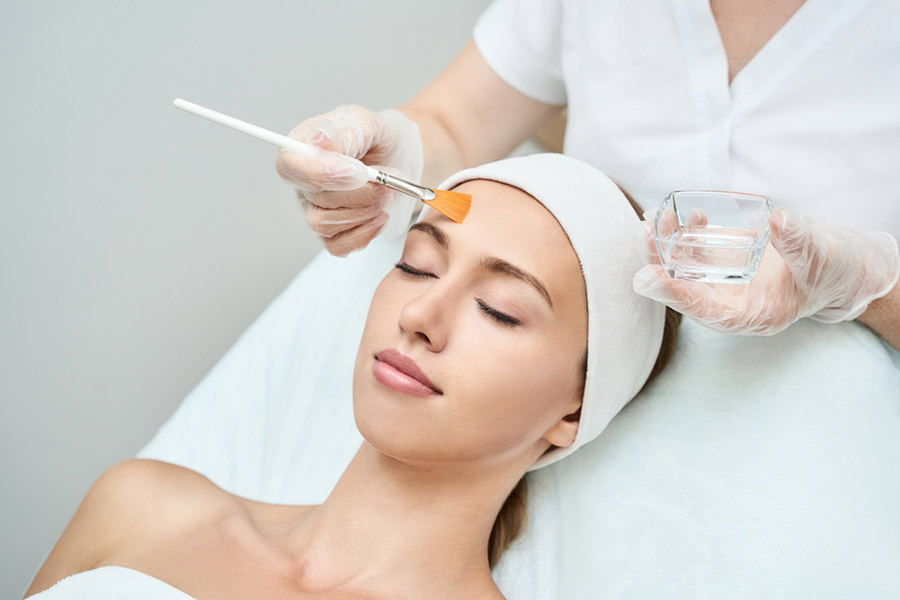What Is a Chemical Face Peel?

By elenavolf / Shutterstock.com
You’ve no doubt heard of a chemical face peel before — but do you know what a face peel does? Chemical face peels are available as both at-home and in-office treatments, and they can help to address a variety of skincare concerns. To help you decide whether a chemical peel might work for you or not, we’ll explain what a chemical face peel is and what treatments are available in this quick guide.
What is a chemical face peel?
A chemical face peel treatment is used to remove the top layers of skin by using chemicals to dissolve the bonds between dead skin cells. The most common chemicals used in this treatment belong to the family of alpha hydroxy acids (AHA); popular examples include glycolic acid and lactic acid. Chemical peels at dermatology offices are offered in different strengths. The three levels of professional chemical peels are:
- Light chemical peel
- Medium chemical peel
- Deep chemical peel
The stronger the peel, the more skin it removes (and the longer the recovery period will be). However, lighter peels often take multiple treatments to achieve the desired results, and have to be repeated more frequently. Light chemical peels can be done as frequently as once a month, while medium peels can be done every four to six months depending on your skin. Deep peels should only be done once every two to three years, at most, due to their intensity.
At-home chemical peels can be done more frequently, however. While their results may be more superficial than in-office treatments, they can be repeated more frequently. For instance, our Caviar Lime Acid Face Peel, which features 10% glycolic acid, can be used one to two times a week as tolerated. At-home chemical peels like this one are great for removing dry skin patches, evening out skin tone, brightening your complexion, and clearing out clogged pores.

What skin conditions can a chemical face peel treat?
Chemical face peels can treat a variety of skin problems, depending on the ingredients used and their concentration. Your dermatologist may recommend a chemical peel for the following skin conditions:
- Fine lines and wrinkles
- Superficial scarring
- Skin discoloration such as age spots and melasma
- Certain types of acne
- Clogged pores
- Uneven skin tone and texture
Chemical peels typically cannot address severe wrinkles or pigmentation issues or sagging skin. A dermatologist like Dr. Harold Lancer will be able to talk to you about alternative treatments that may be better suited to your concerns.
Recovery from a Chemical Peel
With at-home treatments like our Caviar Lime Acid Face peel, there is little to no downtime. Depending on how sensitive your skin is, you might want to avoid using other powerful, drying ingredients in the same routine, such as retinols. You should also wear sunscreen every single day since chemical peels make your skin more sensitive to the sun.
Recovery time is usually 1-7 days for a superficial peel, 7-14 days for a medium peel, and 14-21 days for a deep peel. After an in-office peel, your skin will be red, dry, irritated, and possibly swollen. You can use ice packs and over-the-counter pain-relieving medications to manage any pain and swelling. Treated skin might blister, form a crust, or change in color as the healing process moves forward. You will need to avoid sun exposure for weeks or even months while you wait for your skin to heal.

By Microgen / Shutterstock.com
Choosing Between At-Home and Professional Chemical Peels
In-office chemical peels will deliver a more powerful treatment, but they are also more expensive and require a longer recovery time period than at-home chemical peels. If you are looking to get started with chemical peels, an at-home treatment can be a more affordable and accessible introduction to the world of chemical exfoliation. If your face tolerates the AHAs well and you want to upgrade to a more powerful treatment, then you can seek out a dermatology office like Dr. Harold Lancer’s for a professional chemical peel.
For more information about exfoliating your skin at home, be sure to check out our other skincare guides. We’ve explored in depth how often to exfoliate your skin, what a chemical peel does to your face, and how to exfoliate your skin six different ways. We’ve also delved into other skincare topics, from how often to wear sunscreen to how to remove the makeup the right way, to help you build the best skincare routine possible.
Ready to try our at-home face peels for yourself? Order our Caviar Lime Acid Face Peel today and get free shipping on your U.S. order, no order minimum needed! All of our products also come with a 30-day money-back guarantee so that you can shop with confidence and see how Lancer Skincare products work for yourself.
 PREVIOUS (Best Skincare Gifts for Everyone on...)
PREVIOUS (Best Skincare Gifts for Everyone on...) NEXT (Lancer Skincare Official Skincare Sponsor...)
NEXT (Lancer Skincare Official Skincare Sponsor...)